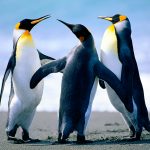The OA is C. But in the passage avian as well as non-avian species have been discussed. How B is wrong and C is right ?
Social learning in animals is said to occur when direct or indirect social interaction facilitates the acquisition of a novel behavior. It usually takes the form of an experienced animal (the demonstrator) performing a behavior such that the native animal (the observer) subsequently expresses the same behavior sooner, or more completely, than it would have otherwise. One example of social learning is the acquisition of preferences for novel foods. Some experiments have suggested that among mammals, social learning facilitates the identification of beneficial food items, but that among birds, social learning helps animals avoid toxic substances. For example, one study showed that when red-wing blackbirds observed others consuming a colored food or a food in a distinctly marked container and then becoming ill, they subsequently avoided food associated with that color or container. Another experiment showed that house sparrows consumed less red food after they observed others eating red food that was treated so as to be noxious. Studies on non-avian species have not produced similar results, leading researchers to speculate that avian social learning may be fundamentally different from that of mammals. But Sherwin’s recent experiments with domestic hens do not support the notion that avian social learning necessarily facilitates aversion to novel foods that are noxious or toxic. Even when demonstrator hens reacted with obvious disgust to a specific food, via vigorous head shaking and bill wiping, there was no evidence that observers subsequently avoided eating that food. Sherwin’s research team speculated that ecological or social constraints during the evolution of this species might have resulted in there being little benefit from the social learning of unpalatability, for instance, selective pressures for this mode of learning would be reduced if the birds rarely encountered noxious or toxic food or rarely interacted after eating such food, or if the consequences of ingestion were minimal. In a related experiment the same researchers showed that if observer hens watched demonstrator hens react favorably to food of a particular color, then observer hens ate more food of that color than they ate of food of other colors. These results confirmed that avian species can develop preferences for palatable food through social learning.
The primary purpose of the passage is to discuss the
A. techniques used in certain experiments on social learning in birds
B. reasons for the differences between social learning in birds and in mammals
C. question of how social learning manifests itself in birds
D. basis for a widespread belief about a difference in behavior between birds and mammals
E. possible reasons why birds may or may not learn from each other in a particular way
B say -> differences between social learning in birds and in mammals
but entire passage is all about Examples of the demonstrator and the observer patterns and except 1st all other are related to birds which start after
but that among birds, social learning helps animals avoid toxic substances …
I might miss a word or two but didn’t identify any difference pointed out extensively. But i think eliminate is the way to go about this question.
Eliminate A,D,E right away and no difference pointer found so eliminate B as well.
Left with C.
Cross check C with map . look +ve so go ahead.
@expert can provide more info.
Out of 25 lines – 4 lines are for mammals and 21 lines are for birds. In fact no example of social learning in mammals have been provided.
Arun


